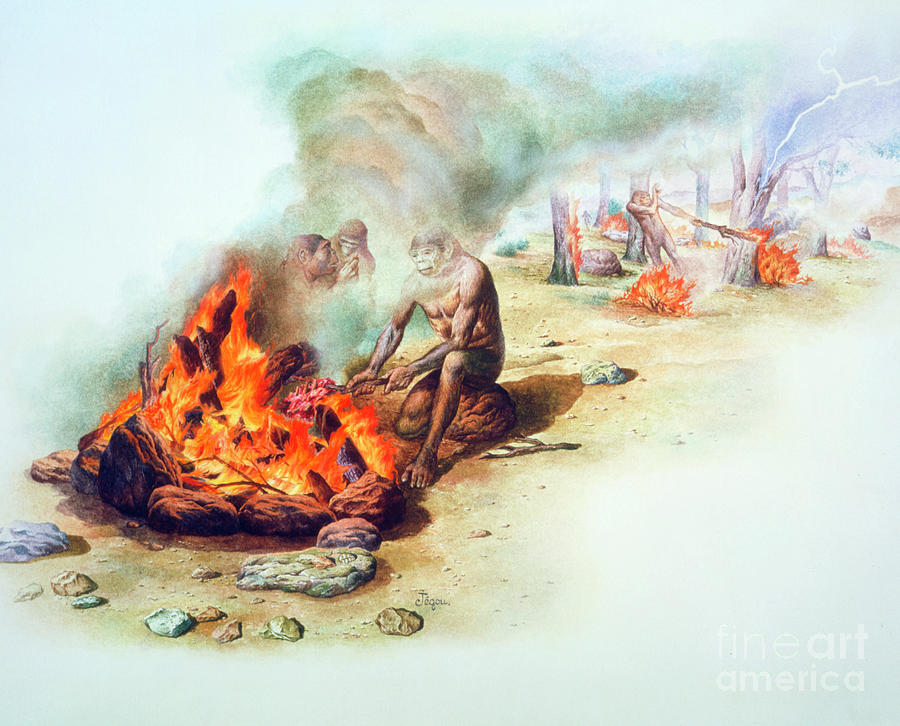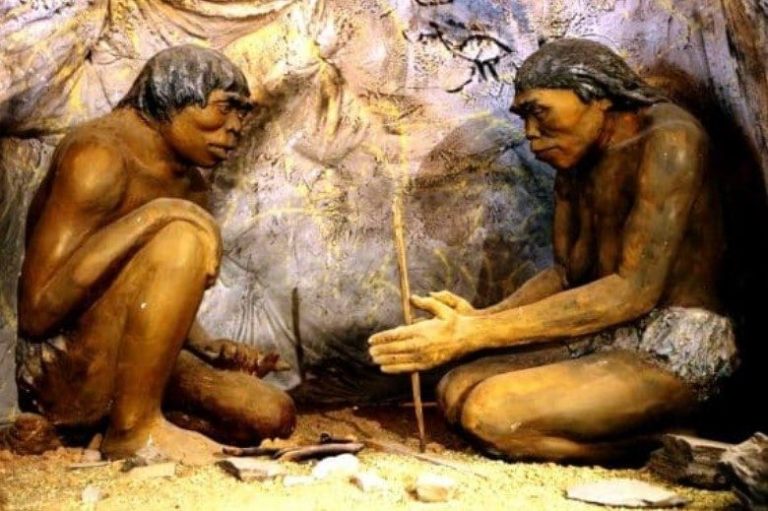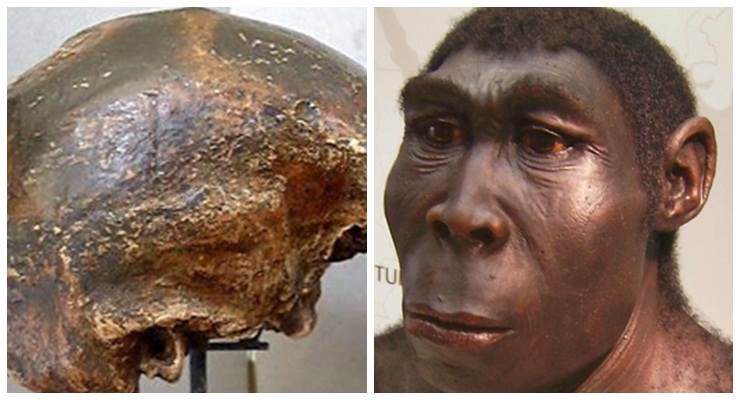How Has the Human Brain Evolved?
- 2022 July 18
- Others
Although the human species has many differences, they all share several common traits. The first thing that catches your eye is the…
Read More
Man took a giant step on the way to the top by taming the fire It is possible that some species of people catch fire from time to time
was used as early as 800,000 years ago. And 300,000 years ago Homo erectus, Neanderthals and the ancestors of Homo sapiens were already making fire every day. Since then, it has become a reliable source of light and heat for man, yes even with a deadly weapon, defending against prowling lions.
It is possible that soon after, people began to intentionally set the neighborhood on fire. Intelligently managed the fire turned the impenetrable heathlands into fine meadows, teeming with game. In addition, after the fire is extinguished, stone age traders could easily walk among the smoldering stumps and gather charred animals, nuts and tubers.
But fire was most useful in cooking. Food that people cannot digest in its natural form – wheat, rice and potatoes – became the basis of our menu precisely because of the fire. It changed not only the chemical, but also the biological properties of food. When boiling or cooking killed microbes and parasites in the food. Also, for people it has become much easier to chew and digest old favorite things: fruits, nuts, insects and food. One hour was enough for people who ate thermally processed food to get stronger for the whole day meals, and the chimpanzees had to chew raw food for the whole five hours per day.

Fire allowed humans to eat a wider variety of foods, spend less time eating, and get by with smaller teeth and shorter intestines. Some scientists believe that the human intestine shortened and the brain enlarged precisely because it began to produce food on fire. Because both a long gut and a huge brain
require huge energy costs, the two are difficult to reconcile.
When man started to cook food on fire, his intestines became shorter and a lot of energy was released – this is how the conditions for the giant brains of Neanderthals and sapiens emerged.
Fire also opened a gap between man and other animals. Almost all animals are dependent on the capabilities of their bodies: muscle strength, teeth size, wingspan. Although being able to harness the winds and currents, they do not know how to control these forces of nature and always remain limited by themselves physical structures. For example, to soar, an eagle recognizes rising currents of warm air, spreads its giant wings, and lets
for hot air to blow it up. However, he is unable to arouse these air currents, and their carrying capacity will always remain strictly proportional to the eagle for wingspan.
By taming fire, humans mastered the docile and potentially limitless the power Unlike the eagles, they could choose when and where to light the fire themselves, eventually learning to use it for a variety of purposes.
Most importantly, the power of fire was not limited by the shape, structure or capacity of the human body. Unaided by anyone, a woman armed with a flint or a flint could in a few hours turn to ashes the largest forest Friendship with fire was a harbinger of future events.

Although fire has brought great benefits to man, 150,000 years ago it was still was still an insignificant animal. True, now people already knew how to scare away lions, to keep warm on cold nights, and occasionally to get squished the forest However, in total, there were only about a million people, living between the Indonesian archipelago and the Iberian Peninsula, a tiny dot in ecological radar readings. Our own species, Homo sapiens, had already ascended the world scene, but for the time being he was only concerned with his survival in the corner of Africa. We do not know exactly where and when the animals that can already be named like Homo sapiens, evolved from earlier humans, but most scientists agrees that 150,000 years ago East Africa was already inhabited sapiens, who looked just like us. If one of them unexpectedly found in a modern morgue, the local pathologist would not notice any his strange features. Fire rewarded them with smaller teeth and jaws, and their brains were the same size as ours. Scientists also agree that 70,000 years ago sapiens from the East Africans spread over the Arabian Peninsula, and from there it did not take long to flood the whole Eurasian landmass.
When Homo sapiens moved to Arabia, most of Eurasia already was inhabited by other human species. What happened to them? There are two conflicting theories. The hybridization [interbreeding] theory tells us that different people felt sexual attraction, mated and mingled. As they spread around the world, immigrants from Africa interbred with the natives humans and humans today are the result of this hybridization. For example, when they reached the Middle East and Europe, they met Neanderthals. These were more muscular than sapiens, had larger brains and were better adapted to cold climates. Used tools and fire, hunted well and, as far as can be determined, took care of the sick and infirm. (Archaeologists have found bones of Neanderthals who lived for many years, tortured serious physical handicaps, which indicates that relatives looked after them.) Neanderthals are often depicted in cartoons as fierce and cavemen are blunt, but recent research suggests otherwise. According to the theory of hybridization, sapiens arrived in the land of Neanderthals interbred with the indigenous people until the two populations merged. If this theory correct, the current inhabitants of Eurasia are not pure sapiens. They are a mixture of sapiens and neanderthals. And after reaching East Asia sapiens interbred with local Homo erectus, so there are Chinese and Koreans a mixture of sapiens and erectus.
The opposite view, called substitution theory, tells us a completely different story: about incompatibility, disgust and perhaps even genocide. According to this theory, the anatomy of sapiens and other humans differed significantly, it is very likely that their mating did not match habits, even body odor. So they had very little sex to be interested in each other. Even if Neanderthal Romeo and sapiens Juliet had fallen in love, their descendants would not be able to have children, because these the two populations were already separated by an insurmountable genetic gulf at that time. Her were completely different, and after the Neanderthals died out, forever their genes also perished. According to this view, sapiens earlier humans changed populations without mixing with them. If this is true, all modern humans are descended from East Africa, and our kin the line began 70,000 years ago. In that case, we are all “purebreds.” sapiens\ This debate is very important indeed. From an evolutionary point of view, 70,000 years is a relatively short period of time.
If the replacement theory correct, the genetic baggage of all people living now is approx equal, and all racial differences play no more important role role. If the hybridization theory is correct, Africans, Europeans and Asians likely have different genes inherited from populations that lived there hundreds of thousands of years ago. This approach would be a political bombshell and would give rise to explosive racial theories.
In recent decades, it has been customary to explain human evolution in terms of replacement theory. It was more strongly supported by the data of archaeological excavations, moreover, it was more politically correct (claiming that modern human populations differ greatly genetically, scientists inevitably would open a Pandora’s box of racist sentiments, which they are not did not desire). A threat to the dominance of this theory emerged in 2010 with the publication of a four-year map of the Neanderthal genome. Of the fossilized fossil geneticists have collected enough intact Neanderthals DNA to compare it to the DNA of present-day humans. The results stunned the scientific community. It turned out that modern people living in the Middle East and in Europe, has 1-4 percent. Neanderthal DNA. This number is not very large but significant. No less scientists were surprised after a few months when DNA extracted from a Denisovan fossil was tested finger The results showed that almost 6 percent unique modern The DNA of the Melanesian Archipelago and Australian Aborigines overlaps with that of the Denisovans DNA.
If these results can be believed – let’s remember that they are still being carried out studies can confirm or change these conclusions, – hybridizations proponents of the theory are at least partially correct. However, this does not mean that that the replacement theory is completely wrong. Because Neanderthals and the Denisovans contributed very little to modern man genome, to suggest that sapiens merged with other human species, is very difficult. Although the first differed from the second not so much that could not have offspring, those differences were enough that such their relations would be very rare. How then to explain the biological sapiens, Neanderthals and Denisovans kinship? It is certain that they were not entirely different species, what horses and donkeys are like. On the other hand, they were not separate from the same species populations like, say, bulldogs and spaniels. Biological reality it’s not just black and white. There are also gray areas, no less important. Any two species that evolved from a common ancestor, such as horses and donkeys, once only two populations of the same species, what are bulldogs and spaniels like now. It certainly should have been a period of time during which the two populations diverged considerably, but could still have intercourse and produce fertile offspring. But another mutation severed the last binding ties and so populations followed separate evolutionary paths. Sapiens, Neanderthals and Denisovans seem to be the borderline point reached about 50,000 years ago. They no longer belonged to the same species, although you couldn’t call them completely separate species yet. How will we find out reading the next chapter, sapiens at that time from neanderthals and Denisovans were very different not only in genetic code and physical features, but also with his cognitive and social abilities, although, judging by everything, in rare cases, sapiens and neanderthals could be fertile descendants.

So the populations did not merge, but for a few random ones Neanderthal genes managed to jump on the sapiens fast train. It would be it’s really strange and even scary to think that we sapiens once could to have sex with other species of animal and to have children with them. If Neanderthals, Denisovans and other human species did not merge with sapiens, the question is why did they disappear? One of the possibilities as follows: Homo sapiens simply displaced them. Imagine a herd of sapiens, having reached some valley of the Balkan Peninsula, where hundreds of thousands Neanderthals lived for years. The newcomers began to hunt deer, to collect nuts and berries, which Neanderthals also ate from time immemorial. Better tools and social skills helped sapiens to hunt and to collect more successfully – as a result, they multiplied and spread. For the less resourceful it became increasingly difficult for the Neanderthals to get lost. Their population waned, gradually they died out completely, except for one other that joined the sapiens who lived in the neighborhood. Another version is possible: competition for resources led to violence, genocide began. After all, sapiens, it must be admitted, is not characterized by greatness tolerance. Even nowadays, rather minor skin color and dialect are enough or religious differences, so that one group of sapiens sets out to exterminate another. How then can we expect that the ancient sapiens behaved much more tolerantly with a completely different kind of people? It is quite possible that sapiens faced with the first and most significant ethnic cleansing began with the Neanderthals campaign in history.
Be that as it may, Neanderthals (and other human species) ask perhaps the most serious “what if?” questions in history. Imagine how things would have gone if together with Homo sapiens Neanderthals and Denisovans would also have survived. What cultures, societies and political structures would have emerged in a co-existing world different types of people? How, for example, would religions have evolved? I wonder if Genesis would have declared Neanderthals to exist descended from Adam and Eve, had Jesus died for the sins of the Denisovans, and the Koran – leaving places in heaven for virtuous people of all kinds? Are Neanderthals would be allowed to serve in the Roman legions and in the exorcism In the Chinese imperial bureaucracy? Is American Independence the declaration would have reflected as a self-evident truth that are all members of the genus Homo created equal? Would Karl Marx have urged unite all kinds of proletarians?
Over the past 10,000 years, Homo sapiens has become so used to the idea that that they are the only human species, that we usually have a hard time even imagine a different possibility. True, it is easier without siblings to consider themselves the pinnacle of creation and to wander about us from the rest of the animals the chasm that divides the kingdom. When Charles Darwin stated, that Homo sapiens is just one of the animal species, people were very indignant. Even today many of us refuse to believe it. Would we consider ourselves unique, if neanderthals had survived? Possible item, just because that’s why our ancestors exterminated them. They were too much like us not to notice, but too different to tolerate.

Sapiens to blame or not, it is clear that when they arrived in new territories local populations soon disappeared. The latest remains of Homo soloensis dating back 50,000 years. Homo denisova also disappeared in a short time. Neanderthals died out about 30,000 years ago. The latest dwarves people lived on the island of Flores approximately 12,000 years ago. They left behind a pile of bones, stone tools, some of our genes DNA and many unanswered questions. Also left us, Homo sapiens, the last human species. What was the secret of sapiens success? How did we make it so fast adapt to such distant and ecologically diverse habitats? How we pushed all other human species into oblivion? Why our attack not even the strong, thinking, cold-fearing Neanderthals could withstand it. Hot debates on these issues are still ongoing. Most likely that we’ll answer all of them by mentioning what makes that debate possible to go: Homo sapiens‘ conquest of the world was helped most by a unique language.
Also I recommend watching Kurzgesagt – In a Nutshell channel animated video clip that will give more information about what happened before history.
Join The Discussion